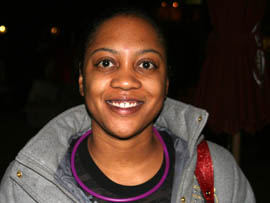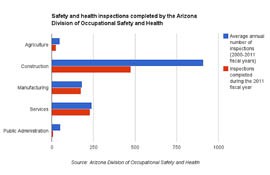Cronkite News has moved to a new home at cronkitenews.azpbs.org. Use this site to search archives from 2011 to May 2015. You can search the new site for current stories.
State’s workplace-safety efforts focus primarily on construction
PHOENIX – As a former room service worker at a Phoenix hotel, Daria Ovide said she saw housekeepers harm their backs, knees and wrists lifting dozens of heavy mattresses each day.
Now a spokeswoman for Unite Here Local 631, a union representing 2,000 of Arizona’s hospitality workers, she wants more done to protect their health and safety.
“The reality is that being a hotel housekeeper is not a little light dusting. It’s incredibly grueling work,” Ovide said. “By age 55 you physically cannot work anymore. Nobody can afford to retire at 55.”
Employees in Arizona’s accommodation industry are about as likely to be injured on the job as construction workers, according to the U.S. Bureau of Labor Statistics. Approximately 3.5 percent and 3.65 percent of accommodation and construction employees, respectively, reported injuries during 2011.
Meanwhile, workplace inspections conducted by the Arizona Division of Occupational Safety and Health (ADOSH) focus mostly on construction.
Darin Perkins, director of ADOSH, said the reason is simple: The construction industry has more serious and sometimes life-threatening risks.
“The hazards that you have present one day aren’t necessarily the hazards you have present the next day or even the next hour,” Perkins said. “Things are constantly changing.”
Ovide said she understands that hotel housekeepers face far different hazards than construction workers, who can suffer injuries or worse from heavy equipment, falling objects and tumbles. Still, she argues, the demanding workload of hotel workers warrants more attention from the state.
“The reality is that service jobs are the jobs that we have now. These are the jobs that are growing,” Ovide said. “They need to understand what they’re looking for, which you could learn by talking to any hospitality worker.”
The job
Crystal Parhams, a hotel housekeeper at the Westin Phoenix Downtown and a member of Unite Here Local 631, said she and her co-workers often do pre-shift stretches to prepare for the physically demanding job ahead.
Parhams said that one morning when she didn’t have time to stretch she ended up with a lumbar strain, an injury to the lower back, after bending down too quickly to tuck in a bed sheet.
“I wasn’t walking. My boyfriend had to carry me in the house,” Parhams said.
“My back always hurts, just from working, but not like that,” she added. “I still worry about it.”
Parhams is among nearly 43,000 accommodation workers in Arizona and among more than 270,000 employed in leisure and hospitality, according to the U.S. Bureau of Labor Statistics.
Experts say housekeepers and other hotel employees more commonly face repetitive-strain injuries to the muscles, tendons and nerves caused by overexertion and repeated motions of particular body parts. This class of injuries, often referred to as musculoskeletal disorders, ranges from carpal tunnel syndrome to herniated discs.
Overexertion and repetitive-motion events causing injury constituted about a quarter of all workplace-injury claims in Arizona during 2010, according to the U.S. Bureau of Labor Statistics’ Census of Fatal Occupational Injuries and the Industrial Commission of Arizona.
The Westin Phoenix Downtown takes many measures to make sure it’s a safe workplace, according to a statement emailed by Katie Brashear, complex director of public relations for the hotel.
“To ensure safety is top of mind, all employees participate in a mandatory training that reviews safe practices on everything from OSHA training to tips and guidelines on how to avoid strains, sprains, slips and falls,” the statement said. “This training outlines attire that is safe to wear in the workplace and includes recommendations on how to best use a ladder and pick up boxes or other materials.”
Pamela Vossenas, health and safety director of UNITE HERE International Union, said there are hazards facing those who clean rooms that tend to go unnoticed because their work occurs behind the scenes. Housekeepers, by the nature of their job, are supposed to be invisible, she said.
“Somehow you leave your room in the morning, it’s a mess, and by magic you come back and everything’s clean and lovely and fluffy,” Vossenas said. “The fact is, these women work very hard, make great sacrifices, but at the end of the day they’re in a lot of pain.”
Pam Tau Lee, former coordinator of the School of Public Health’s Labor Occupational Health Program at the University of California, Berkeley, said that the rise of luxury hotels in the last decade has led to added amenities and contributed to heavier workloads.
Lee, a former housekeeper, said the work that others have traditionally performed – things like delivering linen or changing shower curtains – has also shifted to housekeepers.
“If they could figure out a robot that could clean the rooms, they would replace the people with the robot,” she said.
Research and response
Within the hotel industry, Hispanic hotel housekeepers are the most injury-prone demographic and role, according to a 2010 study by the American Journal of Industrial Medicine.
The study, which examined incidents from five unionized hotel companies over a three-year period, found that the overall injury rate among hotel employees was 5.2 injuries per 100 worker-years, 7.9 for housekeepers and 10.6 for Hispanic housekeepers. Vossenas, of the UNITE HERE International Union, was one of several co-authors.
Niklas Krause, who also helped conduct the study, said there is underreporting of injuries in the hotel industry as well as differing injury rates among ethnicities that need to be acknowledged.
“It’s not a job that can be sent to another country,” Krause said. “We are responsible and remain responsible for cleaning this up and making sure that these injury rates go down.”
Krause also serves as the director of the National Institute for Occupational Safety and Health’s Southern California Education and Research Center and is a professor in environmental and health sciences at the University of California, Los Angeles.
He said some establishments don’t provide the basic tools workers need to do their jobs – a mop to clean the floor, for example.
“They’re supposed to do the bathroom kneeling?” Krause said. “This is not right. This is not something that should be required.”
Hospitality workers are also less likely to have benefits, said Ovide, the spokeswoman for Unite Here Local 631. For example, companies that fulfill manpower needs by offering hotels temporary help don’t offer health insurance, she said.
“Any pain – you take two, four, five, 10 Advil and go on with your day,” Ovide said. “It’s one thing if a construction worker has a repetitive strain injury from lifting, but he or she has health insurance.”
Michael Doyle, member of the board of directors and incoming president of the Hospitality Asset Managers Association, which serves as a collective voice for hospitality firms, said that costs associated with worker injuries have a direct impact on hotel performance and profitability and are addressed as such by the industry.
“Issues around staff and management safety are certainly a critical concern to us,” Doyle said. “We encourage our owners as well as our operators to closely monitor what is happening.”
Eric Reller, director of legislative communications at the American Hotel and Lodging Association, a national organization representing the lodging industry, said that the low turnover among hotel employees speaks to good working conditions.
“It’s a people profession. We need to make our employees happy in order to make our employees work with the guests,” Reller said. “It’s well-paying work for a very nice lifestyle.”
Oversight
Since 2000, 63.4 percent of workplace safety inspections conducted by the Arizona Division of Occupational Safety and Health have involved construction sites, according to records the office provided to Cronkite News.
Service-providing workplaces, like hotels and hospitals, have received 16.7 percent of all inspections.
Perkins, the office’s director, said repetitive-strain injuries, which are more common in service industry workplaces, are difficult to prevent through inspections.
“I could probably count on both hands the number of ergonomic-related citations that we’ve issued over the last decade,” Perkins said.
“We can’t just go out and issue a citation to an employer because an employee does something repetitively every day,” he added. “That in and of itself is not a violation of any standard.”
He also said that construction sites are in the public eye unlike many service-providing industries and as a result his office receives more calls and letters alleging problems.
“It’s easy to drive by a construction site, see that a guy is standing up on top of a wall, exposed to a fall, and then call that into ADOSH,” he said.
Perkins said that in recognition of the fact that the workforce is evolving his office has started putting more effort into other sectors. During the 2011 fiscal year, the latest for which figures were available, construction inspections accounted for 52 percent of total inspections, while 25 percent of inspections took place in service-providing industries.
“Are there other areas that I think are a problem that we need to address?” Perkins said. “Well, yes. And I think our goals for the coming years kind of focus on that.”
The office plans to conduct more inspections as well as additional consultation and training among residential care facilities and nursing homes due to high worker-injury rates, Perkins said.
Price Fishback, the Thomas R. Brown Professor of Economics at the University of Arizona’s Eller College of Management, said weighing accident severity by industry provides a better measurement of where inspectors should focus their attention. That supports focusing workplace inspections on construction, he said.
“If you only have two injuries a year but they’re both deaths, the payoff is going to be in the millions of dollars versus a lot of small injuries,” Fishback said.
Eric Lutz, assistant professor of environmental and occupational health at the UA’s Mel and Enid Zuckerman College of Public Health, said inspections haven’t kept pace with the number of hotel and other service industry employees. He attributed that to a lack of resources.
“They’re doing what they can with the resources that have been allocated to them,” Lutz said. “They’re too constrained to just reacting to the catastrophes, the major significant injuries or even fatal incidents.”
That leaves individual trade associations, unions, corporations and business owners to mitigate the risks, Lutz said.
“It costs them money to have employees injured,” Lutz said.
Perkins said employers that brush off employee concerns end up having the biggest problems. That’s why the office has tried to focus on education and consultation rather than issuing citations, he said.
“Employees don’t feel like their concerns are being taken seriously, and they end up running to ADOSH or some other organization, and the issue just snowballs,” Perkins said.
ADOSH is the only state OSHA program that has an independent body, the Industrial Commission of Arizona (ICA), overseeing the number of the citations issued. The ICA is funded by an annual tax on workers compensation premiums that contributes to ADOSH programs. The rest of ADOSH’s funding comes from the federal Occupational Safety and Health Administration.
The office’s current annual budget is approximately $5.67 million, a 16.6 percent increase over its 2008-2009 budget, which was $4.86 million. This includes OSHA-related operations only.
Twenty-six compliance officers in Perkins’ office completed at least one inspection during the 2011-2012 state fiscal year. That’s 5,000 establishments per inspector.
“The resources that we have currently are adequate for the job we need to do. That’s not to say that we couldn’t use more,” Perkins said. “Our work is cut out for us.”











